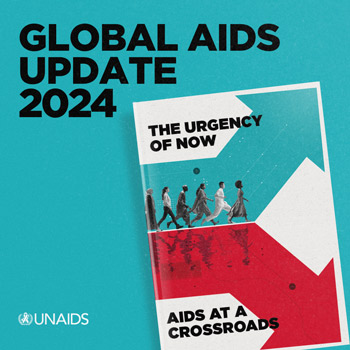The Urgency of Now
New global update from UNAIDS highlights progress but warns countries need to stay on track to end AIDS

UNAIDS has released its 2024 global AIDS report, The Urgency of Now: AIDS at a Crossroads, providing a status update for ending AIDS as a public health threat by 2030.
Although the report highlights progress in significant areas, that progress is “highly uneven.” The global AIDS response is at a crossroads, the report states, and success or failure will depend on whether or not leaders, community members, and program managers can work together to improve access to HIV services, including cutting-edge treatment and prevention, fully support human rights, and bolster funding, among other goals.
The good news first. In 2023, fewer people acquired HIV than at any point since the late 1980s. About 77% of people living with HIV—an estimated 30.7 million—were receiving antiretroviral therapy, which has reduced the numbers of AIDS-related deaths to 630,000, the lowest level since their 2004 peak. Around 73% of people living with HIV on treatment had a suppressed viral load in 2023, up from 40% in 2015. One striking fact that reflects the gains made in treatment coverage: Average life expectancy in sub-Saharan Africa, the region hardest hit by AIDS, has increased from 56.3 years (2010) to 61.1 years (2023).
But there’s much more work to be done. New HIV acquisitions are increasing in at least 28 countries, with three regions in particular—eastern Europe and central Asia, Latin America, and the Middle East and North Africa—experiencing rising numbers. Key populations, whose members are at higher risk for HIV than the general population, are still being neglected by many HIV programs—at least half of all people from key populations are not being reached with prevention services, for example. Treatment coverage is still falling short—9.3 million people are not able to access lifesaving medications, with half of these individuals living in sub-Saharan Africa.
More attention and resources need to be given to improve the health outcomes of children. About 43% of the 1.4 million children living with HIV were not receiving antiretroviral therapy in 2023, a much larger proportion than adults. In addition, while children make up only 3% of people living with HIV, they accounted for 12% of all AIDS-related deaths.
The report also spotlights the importance of working faster to eradicate stigma, discrimination, social inequalities, and gender-based violence to make HIV prevention and healthcare more accessible.
Says Winnie Byanyima, UNAIDS executive director, in the report’s welcome message: “I am sometimes asked whether I am an optimist about the HIV response, because the progress we have made shows the path that ends AIDS—or whether I am a pessimist, because restrictions on resourcing and rights are putting progress in danger. The answer is that I am neither an optimist nor a pessimist—I am an activist, because success depends on rising to the moment, on recognizing the urgency of now.”
Read the full report here.
Share This:
